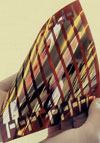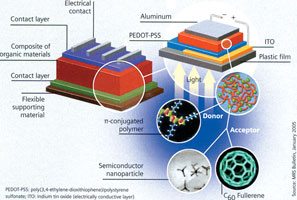
A plastic film that can power a radio on the beach. Solar cells made of organic materials have brought this vision within reach.
Konarka, a leading manufacturer of these materials, has joined forces with Siemens and is planning to introduce its first prototypes this year.
They look like oversized photographic negatives, but they also have some of the characteristics of leaves. They can generate energy from sunlight and are made of organic materials. Welcome to the world of organic solar cells. And unlike their inorganic silicon relatives, which dominate 95% of today's solar cell market, these plastics can be produced faster and at much lower cost, because they do not require high-purity crystals, which must be grown. This means they create opportunities for entirely new applications, such as plastic films that can power small devices.

Initially, solar cells made of organic semiconductors offered very low efficiencies - barely 1%, compared to the 14% to 17% of conventional silicon cells. That is because photons impinging on plastics do not immediately produce electrons; they generate excited states that must then be converted into free charge carriers. Nanotechnology paved the way for the breakthrough. A Siemens team in Erlangen incorporated fullerenes - molecules containing 60 carbon atoms and resembling tiny soccer balls - in a matrix of semiconducting polymers. Impinging light liberates electrons within the plastic, which are captured and transported to an electrode by the fullerenes. In early 2004, researchers used this technology to achieve an efficiency of 5% for the first time - a world record.
"10% efficiency has come within our reach. But we are not just out to set records," explains Dr Christoph Brabec, who headed this research at Siemens Corporate Technology. "We want to make products."
After Siemens sold its solar cell activities to Shell Solar in 2002, Brabec and his team initially focused on photodetectors. But that did not give them the opportunity to fully exploit the potential of this technology. That is why a decision was made to involve an external partner with abundant applications know-how in the field. Thus, since August 2004, Massachusetts-based Konarka has been conducting Siemens' organic solar cell business.
Brabec and five of his colleagues transferred to Konarka, where they already had excellent connections from previous joint projects. Konarka is the worldwide leader in organic photovoltaics. Alan J. Heeger was one of Konarka's cofounders back in 2001. In the early 1980s, he and his partners discovered conductive plastics, which earned them the Nobel Prize in 2001.
Just print it
Brabec and his team are now working in Linz, Austria, and Nuremburg, Germany, where Konarka has its European headquarters. "We come from the electronics and semiconductor industry," Brabec explains. "That is why we complement the materials scientists and chemists at Konarka so well."
The company plans to introduce a range of solar cells to the market and is already setting up its first production lines. Prototypes of so-called dye-sensitised cells are scheduled to be delivered by the end of 2005. Konarka researchers are also developing market-ready multilayer solar cells and cells based on composites of two organic materials (see 'How an organic solar cell works' below). They are searching for the ideal combinations of plastics and layer thicknesses, and are developing materials that can optimise the conversion of a broad segment of the spectrum - including infrared - into electricity.
A major advantage of organic solar cells is that they can be produced using a simple printing process. Individual plastic layers are printed, one after the other, on a supporting material, in a process similar to that used by a printing press. However, the production process requires very clean working conditions, because dust particles can lead to short circuits in the nanometer-thin layers.
The initial goal is not to replace the existing technology, such as solar panels used on rooftops. Konarka is instead focusing on the unique characteristics of the new modules. And the fact that they can be dyed and easily shaped creates a multitude of new opportunities. Solar cells sewn into garments could power portable devices, such as mobile phones or the coolest new digital music players, and colourful awnings could some day even serve as electric power sources.
Other applications could range from unmanned vehicles to tents to battery chargers. And since these solar cells can be folded and stored in small spaces anytime, they can recharge batteries in notebooks or mobile phones - even inside buildings. That is because, unlike crystalline semiconductors, organic solar cells can efficiently convert artificial light as well as sunlight.
Three key factors will determine the success of organic solar cells: price, efficiency and service life. And because they are manufactured without complex, high-vacuum crystal growing systems, their cost will probably only amount to approximately one fifth of the cost of those based on silicon. Their efficiency is already considerable, and it will continue to increase. Service life is still a critical factor, though, because the cells are susceptible to oxidation and can be damaged by humidity. What is more, there is still a lack of long-term experience and of standardised test methods that can be used to measure product life of flexible cells.
Konarka's near-term objective is to perfect solar cells that deliver an efficiency of 5%, have a service life of at least three years, and can be manufactured on a commercial scale. Realising these goals would establish Konarka's organic solar cells in the field of consumer electronics.
"You never know. In five to 10 years we might be a dominant force on the power generation market. By then you might see rooftops covered with our solar panels," says Brabec with a confident grin.
Source: Bernhard Gerl; 'Pictures of the Future' - Siemens AG; www.siemens.com/pof
How an organic solar cell works
Conventional solar cells consist of two semiconductor layers. At the boundary surface of these layers, an electric field develops. Impinging photons liberate charge carriers - electrons and holes (ie, ions lacking electrons) that are conducted to the cell's metallic contacts. This causes current to flow in the external electric circuit. Even organic semiconductors can be excited by photons. But when these absorb light, no free electrons are initially generated. Instead, excitons are created - electron-hole pairs that are linked by electromagnetic forces and must first be separated.

This separation is achieved by two layers - one that readily emits electrons (a donor) and another that readily receives them (an acceptor). If such an exciton migrates to the boundary surface between the two layers, the donor transfers an electron to the acceptor. Those charge carriers are conducted to the external electrodes, and the unit generates electric current. Instead of using several layers, composites of two organic materials can also be used. In such cells, donor and acceptor substances, which serve as hole and electron conductors respectively, are mixed. As a result, the entire volume of the solar cell is utilised. In the most successful solar cells, a conjugated polymer, such as poly-(3-hexylthiophene), is used as a donor, and a fullerene as an acceptor.
| Tel: | +27 11 652 2000 |
| Email: | [email protected] |
| www: | www.siemens.co.za |
| Articles: | More information and articles about Siemens South Africa |

© Technews Publishing (Pty) Ltd | All Rights Reserved